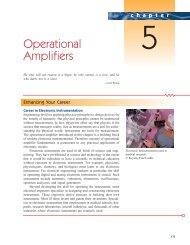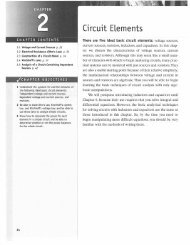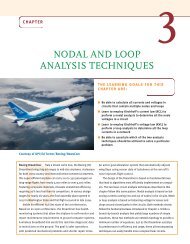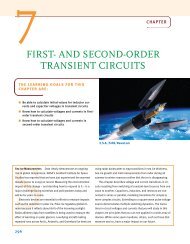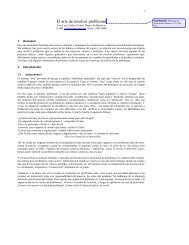You also want an ePaper? Increase the reach of your titles
YUMPU automatically turns print PDFs into web optimized ePapers that Google loves.
SECTION 1.2 <strong>BASIC</strong> QUANTITIES 5<br />
Figure 1.7<br />
Flashlight circuit.<br />
Switch<br />
–<br />
Battery<br />
+<br />
Light bulb<br />
At this point we have presented the conventions that we employ in our discussions of<br />
current and voltage. Energy is yet another important term of basic significance. Let’s<br />
investigate the voltage–current relationships for energy transfer using the flashlight shown in<br />
Fig. 1.7. The basic elements of a flashlight are a battery, a switch, a light bulb, and connecting<br />
wires. Assuming a good battery, we all know that the light bulb will glow when the switch<br />
is closed. A current now flows in this closed circuit as charges flow out of the positive terminal<br />
of the battery through the switch and light bulb and back into the negative terminal of<br />
the battery. The current heats up the filament in the bulb, causing it to glow and emit light.<br />
The light bulb converts electrical energy to thermal energy; as a result, charges passing<br />
through the bulb lose energy. These charges acquire energy as they pass through the battery<br />
as chemical energy is converted to electrical energy. An energy conversion process is occurring<br />
in the flashlight as the chemical energy in the battery is converted to electrical energy,<br />
which is then converted to thermal energy in the light bulb.<br />
Figure 1.8<br />
Flashlight circuit with<br />
voltages and current.<br />
–<br />
Battery +<br />
I<br />
– V battery +<br />
+V bulb –<br />
Let’s redraw the flashlight as shown in Fig. 1.8. There is a current I flowing in this diagram.<br />
Since we know that the light bulb uses energy, the charges coming out of the bulb have<br />
less energy than those entering the light bulb. In other words, the charges expend energy as<br />
they move through the bulb. This is indicated by the voltage shown across the bulb. The<br />
charges gain energy as they pass through the battery, which is indicated by the voltage across<br />
the battery. Note the voltage–current relationships for the battery and bulb. We know that the<br />
bulb is absorbing energy; the current is entering the positive terminal of the voltage. For the<br />
battery, the current is leaving the positive terminal, which indicates that energy is being<br />
supplied.<br />
This is further illustrated in Fig. 1.9, where a circuit element has been extracted from a<br />
larger circuit for examination. In Fig. 1.9a, energy is being supplied to the element by<br />
whatever is attached to the terminals. Note that 2 A, that is, 2 C of charge are moving from<br />
point A to point B through the element each second. Each coulomb loses 3 J of energy as it<br />
passes through the element from point A to point B. Therefore, the element is absorbing 6 J<br />
of energy per second. Note that when the element is absorbing energy, a positive current<br />
enters the positive terminal. In Fig. 1.9b energy is being supplied by the element to whatever<br />
is connected to terminals A-B. In this case, note that when the element is supplying energy,<br />
a positive current enters the negative terminal and leaves via the positive terminal. In this convention,<br />
a negative current in one direction is equivalent to a positive current in the opposite<br />
direction, and vice versa. Similarly, a negative voltage in one direction is equivalent to a positive<br />
voltage in the opposite direction.<br />
A<br />
+<br />
3 V<br />
–<br />
B<br />
A<br />
+<br />
3 V<br />
–<br />
B<br />
I=2 A<br />
I=2 A<br />
(a)<br />
(b)<br />
I=2 A<br />
I=2 A<br />
Figure 1.9<br />
Voltage–current relationships<br />
for (a) energy absorbed and<br />
(b) energy supplied.




